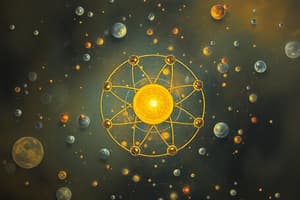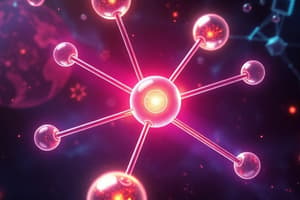Podcast
Questions and Answers
What was J.J. Thomson's hypothesis about the atom's structure?
What was J.J. Thomson's hypothesis about the atom's structure?
- The atom consists only of electrons suspended in space.
- Protons are at the center of the atom, surrounded by electrons.
- Electrons and protons are uniformly mixed throughout the atom. (correct)
- The mass of the atom is concentrated in small regions called nucleons.
What experimental method did Rutherford use to test Thomson's model?
What experimental method did Rutherford use to test Thomson's model?
- Gold foil experiment. (correct)
- Particle acceleration.
- Spectroscopy.
- Chemical reaction analysis.
What conclusion did Rutherford draw from his gold foil experiment?
What conclusion did Rutherford draw from his gold foil experiment?
- Atoms consist entirely of positively charged particles.
- The atom has a uniform distribution of mass.
- The nucleus occupies most of the space in the atom.
- The atom is mostly empty space with a dense nucleus. (correct)
Which of the following accurately describes the observations made during Rutherford's experiment?
Which of the following accurately describes the observations made during Rutherford's experiment?
How does the size of the nucleus compare to that of the entire atom according to Rutherford's conclusions?
How does the size of the nucleus compare to that of the entire atom according to Rutherford's conclusions?
What did Rutherford conclude about the charge of the nucleus?
What did Rutherford conclude about the charge of the nucleus?
What did Thomson's model fail to explain, which Rutherford's experiment addressed?
What did Thomson's model fail to explain, which Rutherford's experiment addressed?
What key aspect of atomic structure was established by Rutherford's findings?
What key aspect of atomic structure was established by Rutherford's findings?
What major limitation did Rutherford's model of the atom face?
What major limitation did Rutherford's model of the atom face?
What does Bohr's first postulate about the electron in an atom state?
What does Bohr's first postulate about the electron in an atom state?
How did Bohr's model explain the emission of radiation from an atom?
How did Bohr's model explain the emission of radiation from an atom?
What aspect of Bohr's model is considered entirely incorrect?
What aspect of Bohr's model is considered entirely incorrect?
Which force must balance the Coulombic force for the mechanical stability of the electron orbit according to Bohr's model?
Which force must balance the Coulombic force for the mechanical stability of the electron orbit according to Bohr's model?
In which form is the angular momentum of the electron expressed in Bohr's model?
In which form is the angular momentum of the electron expressed in Bohr's model?
According to the principles known in 1911, what should have happened to the nuclear atom?
According to the principles known in 1911, what should have happened to the nuclear atom?
What does the fourth postulate of Bohr's model correctly state about angular momentum?
What does the fourth postulate of Bohr's model correctly state about angular momentum?
Flashcards
Thomson's Model of the Atom
Thomson's Model of the Atom
J.J. Thomson proposed that electrons and protons are evenly distributed throughout the atom, like plum pudding.
Rutherford's Gold Foil Experiment
Rutherford's Gold Foil Experiment
Rutherford used alpha particles aimed at a thin gold foil to test Thomson's model by investigating how they were deflected.
Rutherford's Conclusion from Gold Foil Experiment
Rutherford's Conclusion from Gold Foil Experiment
Rutherford's experiment revealed most alpha particles passed through, with a few deflected significantly, leading to the conclusion that the atom is mostly empty space with a concentrated positive charge in the center.
Rutherford's Experiment Observation
Rutherford's Experiment Observation
Signup and view all the flashcards
Size of the Nucleus vs. Atom
Size of the Nucleus vs. Atom
Signup and view all the flashcards
Charge of the Nucleus
Charge of the Nucleus
Signup and view all the flashcards
Thomson Model Limitation
Thomson Model Limitation
Signup and view all the flashcards
Key Aspect of Atomic Structure
Key Aspect of Atomic Structure
Signup and view all the flashcards
Rutherford Model Limitation
Rutherford Model Limitation
Signup and view all the flashcards
Bohr's First Postulate
Bohr's First Postulate
Signup and view all the flashcards
Bohr's Model and Radiation
Bohr's Model and Radiation
Signup and view all the flashcards
Incorrect Aspect of Bohr's Model
Incorrect Aspect of Bohr's Model
Signup and view all the flashcards
Balancing Forces in Bohr's Model
Balancing Forces in Bohr's Model
Signup and view all the flashcards
Electron Angular Momentum in Bohr's Model
Electron Angular Momentum in Bohr's Model
Signup and view all the flashcards
Nuclear Atom Collapse
Nuclear Atom Collapse
Signup and view all the flashcards
Bohr's Fourth Postulate
Bohr's Fourth Postulate
Signup and view all the flashcards
Study Notes
Models of Atom
- The atom is composed of protons and electrons. J.J. Thomson suggested a model where electrons and protons were mixed within the atom.
- The model of the atom has evolved over time and several prominent models have been proposed.
- Rutherford proposed his model based on experiments where he bombarded gold foil with alpha particles.
- Rutherford's experiments concluded that the atom is mostly empty space and that a positively charged nucleus exists in the center.
- Rutherford’s model explained that the nucleus contained most of the atom’s mass.
- Rutherford's model had difficulties in explaining the stability of atoms and atomic spectra.
- Bohr proposed his model based on the quantum theory of energy.
- According to Bohr, electrons in atoms only occupy specific states of motion, each with a specific energy.
- When transitioning from a higher energy state to a lower state, the atom emits radiation equivalent to the energy difference between the two states.
- Bohr proposed that the atom emits energy when an electron transitions between energy states.
- Bohr proposed that the electron moves in a circular orbit around the nucleus and that the angular momentum of the electron is quantized.
- The Bohr model was significant in explaining atomic spectra and was partially successful in explaining the stability of atoms.
Studying That Suits You
Use AI to generate personalized quizzes and flashcards to suit your learning preferences.




